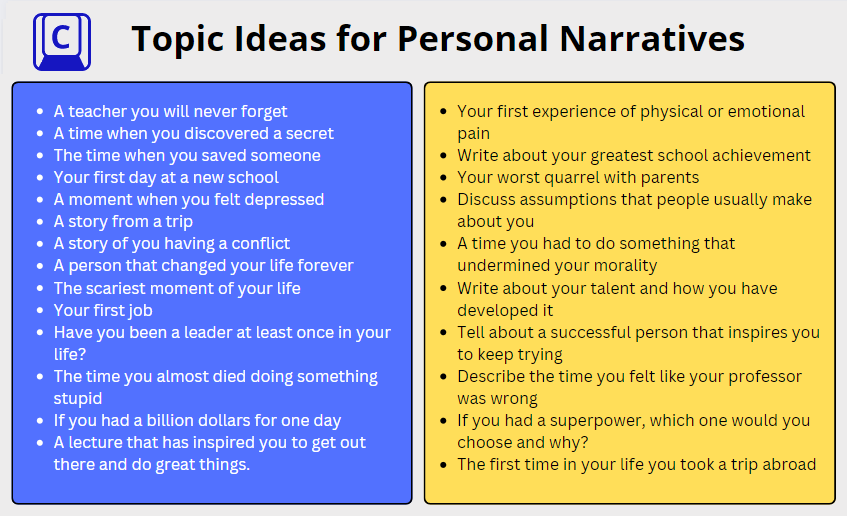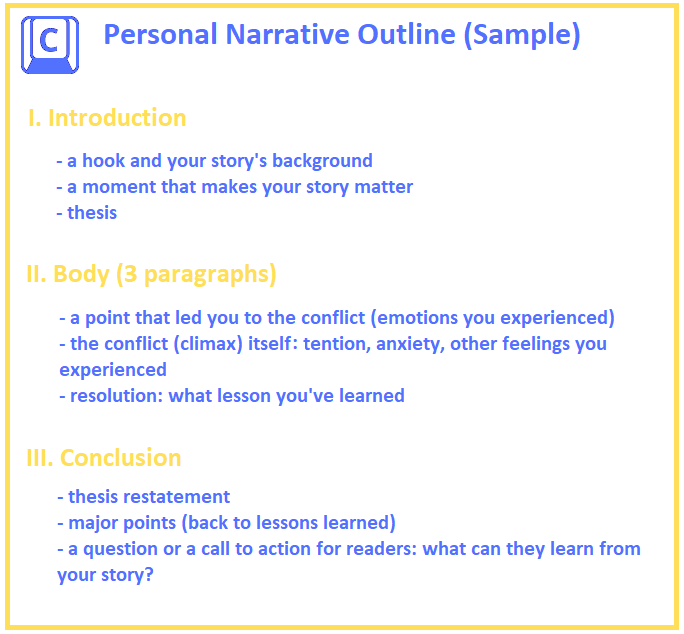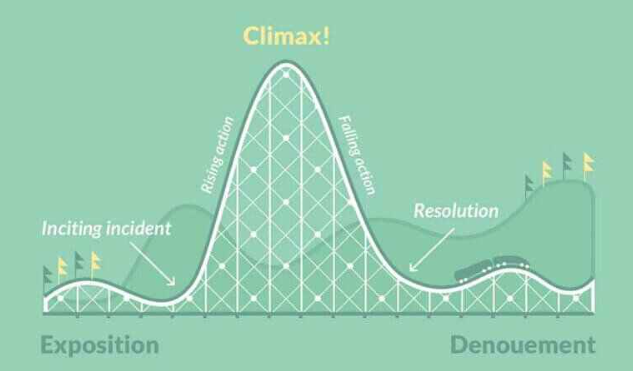How to Write a Personal Narrative: The Ultimate Guide

A personal narrative is a story about you. Simple as that, right?
Not quite.
Once you get the assignment to write a personal narrative essay, tons of questions arise: what exactly to write, how to format this story, how to know if its structure is correct, and what makes it different from other essay types like short story assignment, for example?
This article will answer all your questions and help you understand how to write a personal narrative to get A+. The process may seem time- and energy-consuming, but we promise: It’s not so if you get the core idea behind this writing format.
But still:
If this guide isn’t enough for you to proceed with the paper, our team is always here to provide you with homework assignment help.
What is a Personal Narrative?
A personal narrative is a story with a plot that allows authors to connect to people. It’s about the author’s growth, lessons learned, and reflections on experiences.
It can be an autobiography, a short story about an event that happened to you or a person who influenced you, a personal essay you wrote for magazines like Time or The New Yorker, etc.
Personal Narrative Topics and Ideas
As a rule, teachers don’t assign any particular topic when asking you to write a personal narrative. And such a freedom of choice can be a problem for some students: You stumble and don’t know what to write because you can’t decide on any particular topic that will be interesting enough to engage readers.
Personal narrative ideas and topics are many. You can write about your interests, childhood, school years, student life, relationships, travels, etc. It can be a story about achieving a goal, your realization or failure, your best friend, your biggest mistake or the happiest moment of your life, your childhood memory, and so on.
But when you decide on what to cover in your story, ensure to specify why you choose this moment and why it is important to share.
Here go a few topic examples for your narrative essay:
-
This friendship breakup cost me a year of my life.
-
It was the moment I changed my life philosophy.
-
How I stole a cat that meowed on my dog.
-
If I were a politician, I’d be…
-
Why I’ll never support vegans again.
The Components of a Personal Narrative
A personal narrative is a story, right? So, it stands to reason that it needs to include all the elements of a story: a plot, characters, setting, conflict (climax), and resolution (conclusion).
- Plot: Events happening in your personal narrative.
- Characters: You are a protagonist of the story, and other people you mention there will be the supporting characters.
- Setting: Location and time when the events of your story happen.
- Conflict: The problem you resolve in a story, the challenge you need to overcome, or a moment of tension for you to win through.
- Resolution: The moral of your story. Why do you tell it? What have you learned, and what do you want the readers to understand?
Why Do We Write Personal Narratives?
The purpose of a personal narrative is simple: tell a story that happened to you and reveal the lessons you’ve learned from that experience. This form of writing helps you express thoughts, ideas, feelings, and opinions so that readers get involved and inspired by your story.
Today we use personal narratives on social media when writing about events and experiences that happened to us. You can write it in a blog post, magazine, case study, journal, etc. As a student, you may need to use a personal narrative in the admission essay or cover letter asking to tell your professional story for a potential employer.
In college, students often get an assignment to write a personal narrative essay. The purpose is to learn storytelling and emotional writing, with a focus on self-growth, reflections, and lessons learned from the experience.
With narrative essays, you will learn to tell stories so that others will listen to you.
What is a Personal Narrative Essay?
A personal narrative essay is a form of academic writing where you tell a story about your experience, using the components of storytelling and providing sensory details to get readers involved in what you want to say.
In a narrative essay, you don’t develop arguments and don’t try to persuade readers. That’s what makes it different from other academic papers: You tell a story and let the audience draw their own conclusions from it.
The purpose of narrative essays is to show off your writing skills and provide insight into your thoughts for readers to understand you better. Here you examine universal truths via personal experience.
Below are general characteristics of a personal narrative essay for you to follow:
- It’s informal.
- It comes from the 1st person. (Use “I” or “we” as you are a storyteller here.)
- Its purpose is to inform, not teach or criticize.
- It’s non-fiction: You tell real-life stories that happened to real people and are based on actual experience.
- It follows the structure of academic essays but includes the storytelling elements such as a plot, setting, conflict, characters, resolution, and others.
How to Write a Personal Narrative Essay
Choose a Topic
First, you need to choose what you want to tell the audience. Personal narratives are stories, so do your best to write about something interesting enough to hook readers. It’s okay to write about your interests, the people who influenced you, your experience in childhood or school years, etc.
These tips can help you decide on the topic:
- Think of what bothers you: What would you like to share or discuss with others?
- Go to social media: What do your peers discuss? What does bother them, and what stories do they share with followers?
- Try freewriting: Take a pen and start writing down everything that comes to your mind. After 10-15 minutes, stop and re-read: Are there any ideas you could share in your story?
And here go some personal narrative topic ideas to inspire you:

Write an Outline
A personal narrative has all the components of a story, but it’s your academic assignment anyway. It means you follow an essay structure here, with all critical elements like a thesis in your introduction, three paragraphs in an essay’s body, a conclusion, etc.
To ease the process, organize thoughts, and ensure you don’t forget anything, write an outline for your narrative.
Below is a sample you can use to incorporate all necessary components of a story into your narrative essay:

Write a Draft
Now it’s time to write your narrative essay. Follow the outline and describe each part in detail: Remember that readers weren’t there, so you’ll need to “paint” the picture for them to understand everything.
How to start a personal narrative?
The first paragraph of your essay is a story setup (exposition). Think of a catchy first sentence (a hook) to grab readers’ attention and mention why your story matters (thesis).
The following three paragraphs are your story itself, with all events, the conflict, and a resolution:
- Paragraph 1 is a rising action: tell about the setting, introduce characters, and start writing about the event.
- Paragraph 2 is a climax: here goes the conflict, and you write about how the characters (you) deal with it.
- Paragraph 3 is a falling action: write here about conflict resolution and its aftermath for characters.
Finally, the last paragraph of your essay (conclusion) is a story resolution. Here you write about the moral of your story, why it matters, and share a call to action for readers.
In other words, your story draft follows the structure all authors and screenwriters know as a narrative arc:

Edit It to Follow the Structure
The most challenging part is over — your narrative is ready! Now it’s time to re-read it and check if it follows the structure and has all the storytelling elements for the audience to get engaged and say, “Wow!” after reading it.
Guidelines to follow while writing and editing:
- It’s your story, so write your narrative in the 1st person. (Use “I” and “we” pronouns.)
- The length of narrative essays varies, but think of at least 600 words.
- Pay attention to tenses: As a rule, personal narratives describe the events that happened in the past, so many authors use the past tense. If you decide to write about the present, ensure you keep the present tense consistent throughout your story.
- Tell a story in chronological order.
- Consider the “Show, don’t tell” principle: Provide readers with enough details to imagine and understand your story. The ideal variant is to evoke emotions and make them sympathize.
Proofread Your Essay
The final stage is proofreading: Re-read your narrative essay once again to check it for spelling and grammar mistakes and revise your language for better clarity and readability.
Misspellings, double spacing, too complex sentences — do your best to revise all these for your essay to sound great.
If you use quotes or citations throughout your narrative, ensure to provide proper references to them. Delete repeats, and paraphrase sentences where it might be hard for a reader to understand what you mean.
A good practice would be to ask a friend to read your story before you publish or submit it to a professor. They will provide feedback for you to know if your narrative is interesting enough and how you can make it even more compelling.
Personal Narrative Examples
The best way to learn how to write personal narratives is to read magnificent examples of this writing form, agree? Given that such texts aren’t that long, tons of inspiring examples are easy to find and read online.
For example, here goes The Death of the Moth by Virginia Woolf. Notice how the author uses contract and swings a reader’s emotions with power words and images. By giving human feelings to the moth, Woolf piques empathy, leading us from pity to pathos, triumph, and awe.
Or, let’s take Siri Tells a Joke by Debra Gwartney. In this short text, the author goes through losses and reflects on her grief and how she learned to live without her dearest people nearby.
When reading these examples, imagine you’re Sherlock: You need to examine them to find writing clues to their success. Why are they so great? What makes them so intriguing to readers: opening scenes, vivid imagery, power words authors use to grab attention and make readers sympathize?
The more instruments you’ll distinguish in popular narrative essays, the more you’ll be able to use when writing your work.
And here go your extra resources to check for more writing tips and narrative essay examples:
- Narrative Essay: Characteristics and Examples
- The Narrative Essay: It Differs From a Simple Story
- How to Write Narrative (video by Jeremy Thompson)
Over to You
We hope you have a better idea of how to write personal narrative assignments now. All you need to do is choose an engaging topic and format it as a story with a plot, characters, and lessons you’ve learned from that experience. And remember:
It’s personal yet academic work if assigned in college. Follow the essay structure: Use a hook and thesis in the introduction, develop a story in body paragraphs, and mention the moral of your story in the conclusion.
Any questions left?
Copycrafter’s writers are here 24/7 to assist you with writing assignments. Don’t hesitate to ask for professional help here!